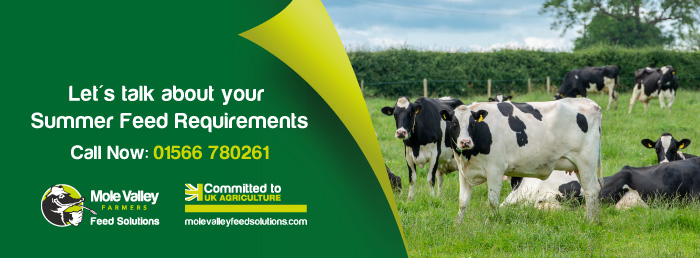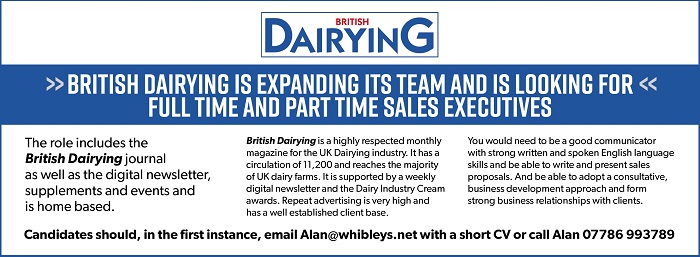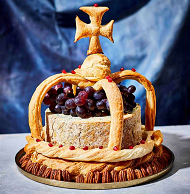|
|
|
|
|
Newsletter May 2, 2023
|
|
UK - Survey reveals 98% of dairy farmers care about sustainability but are concerned about 'the agenda'
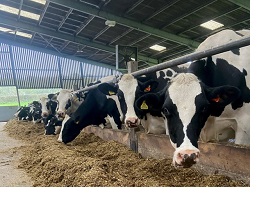 A new survey compiled by KW Feeds reveals dairy farmers are concerned about balancing environmental goals with profitability, but almost all of those questioned overwhelmingly recognise sustainability is important to their business. The survey did however highlight concerns over a lack of clarity when quantifying environmental credentials.
A new survey compiled by KW Feeds reveals dairy farmers are concerned about balancing environmental goals with profitability, but almost all of those questioned overwhelmingly recognise sustainability is important to their business. The survey did however highlight concerns over a lack of clarity when quantifying environmental credentials.
In the survey, 98% of the dairy producers questioned agreed that sustainability was important, with 84% already auditing their farm, or planning to do so, although the majority (79%) were doing so in response to retailer or processor pressure.
Responses revealed some concern to the parameters of different measurements, with experiences of several audits by all the major supermarkets, returning a variety of different results. Given this experience, one respondent questioned the reliability of the auditing process, concerned it was 'making a mockery' of what they feel is 'an already dubious sustainability agenda, making farming the scapegoat'.
Despite this, Charlotte Ward, Ruminant Technical Manager at KW Feeds says the survey shows a positive approach to more sustainable farming activities, including the associated operational costs, as long as milk prices reflect the changes, and consumers are prepared to pay for it. "The majority of farmers we spoke to are optimistic about the benefits of operating in a more sustainable way, even if the costs may be higher now. Many felt that in reality, these changes will be self-funding due to improving efficiencies. Essentially there is a short-term cost for a longer-term gain, for the benefit of us all," she says.
Sustainability benefits clearly need to be linked to performance and profitability, and this is where KW Feeds' focus and innovation into feed efficiency and predominantly home-grown or British sourced low-emission feeds, plays a crucial role. Indeed, 96% of those surveyed felt that using UK feed options were either important or semi-important, not just down to cost, but also from a sustainability perspective (69%).
"While there is clearly a nervousness around hitting the balance between sustainability and profitability, and the lack of a standard across the industry, dairy farmers remain positive they are making a difference for the long-term," she concludes.
KWFeeds
|
|
|
ProCROSS - Crossbreeding for Profit and Production
Insufficient genetic variety in a herd can hinder cow health and fertility, leading to higher costs and lower production. Crossbreeding is increasingly becoming a solution to this problem.
With the right combination of breeds, farmers can significantly improve lifetime production and health, reducing costs and the amount of work per cow. Thanks to its unique cross of Holstein, VikingRed, and Montbéliarde, the ProCROSS system is quickly growing in popularity.
How does crossbreeding lead to healthier cows with better fertility and longer lifespans? What are some of the problems that come with inbreeding? And how does ProCROSS address these issues?
To explore these questions and more, listen to one of the world's foremost dairy crossbreeding experts sharing her insights into the benefits of crossbreeding in this podcast. Amy Hazel Loeschke, PhD in Dairy Crossbreeding, sheds light on the limitations of inbreeding, especially among Holstein cows, and the myriad of advantages the ProCROSS solution offers.

|
|
|
UK - Wynnstay launches new campaign to help dairy farmers improve milk from forage
Wynnstay is launching a Forage4Profit campaign to help dairy farmers maximise the quality of homegrown forage and improve milk from forage. The amount of milk produced from forage averages just 2,900 litres nationally, figures from Kingshay's cost report from December 2022 show. David Howard, head of dairy at Wynnstay, says there is huge scope to improve this and reduce purchased feed costs, with the best farms achieving 5,300 litres of milk from forage. "Every 1,000 litres of milk from forage equates to approximately 460kg of concentrate feed, and so by increasing homegrown forage quality, you can make some significant savings on total feed costs," says Howard. He explains that the target digestibility value for forage is >70, yet of the 1,228 forage samples Wynnstay carried out analyses on, over two-thirds were less than 70 digestibility value, with 12% less than 60. "Forage quality is essential to drive feed efficiency."
He believes this is becoming more important with many milk processors now offering milk producers incentives to reduce soya and improve their total feed efficiency, which is really driven by the quality of forage. "We are launching Forage4Profit, which is a four-point programme to help farmers improve each stage of their forage production from field to feed out. It covers everything from soil health through to seed selection, crop preservation and ration formulation."
Soil health: Making good-quality forage starts with having balanced soils. About 80% of soil samples carried out by Wynnstay are the incorrect pH. Howard says soil health is a limiting factor and will reduce crop growth and quality. He adds: "Producers should carry out regular soil samples and, if there are any imbalances, they should look to correct these. It is also important to identify areas of compaction and aerate soils to combat this, as well as creating bespoke fertiliser plans tailored to individual nutrient requirements."
Seed selection: Should be specific to each farm and will depend on soil type, rainfall and how much forage is required alongside quality targets. "We must remember when we plant a seed in the ground on a dairy farm, the end-product is not necessarily a crop - it's a litre of milk. Milk is the saleable commodity and so seed selection must be linked to what the farmer is trying to produce. "I would recommend reseeding regularly, especially under-performing leys, and working with a grass seed specialist to select the best variety for your farm. Multi-species leys and crops tend to work very well because they are high in protein such as red clover and lucerne," he explains.
Crop preservation: This is often a stumbling block because of the UK's variable weather conditions. David Howard says that once grass is cut that plant is losing energy (sugars) up until it is clamped. Grass should be cut, immediately tedded, wilted, and picked up within the shortest possible time. He adds: "As a starting point, work out the crop's nutrient requirements and apply slurry and nitrogen fertiliser accordingly. It is also important to ensile the crop quickly to reduce dry matter losses and use an effective inoculant to rapidly drop the pH and reduces losses."
Balance the ration: The final part is balancing the rations."The complete diet is only as good as the forage foundation; the best results are achieved with high-quality forage and balanced concentrates.It is important to work with your nutritionist to balance the ration with concentrates to achieve good protein utilisation and efficiency. Using rumen additives such as Diamond V can help increase feed conversion efficiency," he adds. He says improving the quality of home-grown forage can also help to reduce farms' environmental footprint.
Click for more detail on Forage4Profit
|
|
|
UK - We Eat Balanced continues to protect reputation of meat and dairy
An impressive nine out of ten consumers who saw the most recent We Eat Balanced TV advert agreed it successfully communicated that meat and dairy form part of a balanced diet. Reaching a staggering 43 million adults, AHDB's We Eat Balanced campaign ran in Autumn 2022 and January 2023, to drive awareness of the nutritional value that lean meat and dairy can add as part of a healthy, balanced diet.
And the campaign, which is now in its third year, showcased British produce as some of the most sustainable in the world.
In January, We Eat Balanced featured on mainstream TV/on Demand, YouTube, Newspapers, social media and in eight major supermarkets, where eight million on-pack stickers linked shoppers to healthy meat recipes.
AHDB's Director of Marketing Liam Byrne said: "We Eat Balanced is designed to celebrate the positive role meat and dairy can play within a healthy, sustainable diet and dispel negative myths. "At a time when shoppers are facing huge pressures on their budgets, the campaign has played an important role in helping shine a spotlight on the nutritional value red meat and dairy can bring - especially micronutrients such as iron, zinc, and calcium, that we know are found in a more bioavailable form in animal sourced foods."
Our social media campaign also delivered more than 41 million impressions, with new content targeting the next generation of consumers, aged between 18-25. More than 90% who saw the campaign on social platforms said they felt reassured that British meat and dairy are sustainable.
We Eat Balanced also had a positive impact on the perception of specific health benefits red meat and dairy can offer. Six percent more people saw dairy as a good source of vitamin B12 after the campaign, supported by TV's Dr Ranj Singh's.
The campaign enlisted further help from Dr Emily Andre during Iron Awareness Week. This played an important role in highlighting that nearly half of young women in Britain are iron deficient, and the positive role red meat can play as part of a balanced diet. Year-on-year, the campaign continues to reassure consumers about eating meat and dairy, with consumers more inclined to use the information to defend their choices. Conversations around meat and dairy have grown in positivity over the campaign.
AHDB
|
|
|
UK - Inch named as British Friesian Herd of the Year for 2023
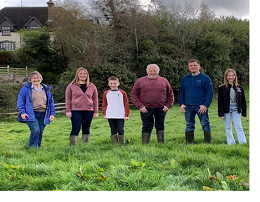 The highly acclaimed British Friesian Herd of the Year Award has been won by the Northern Irish Inch herd. Now in its third year, the award recognises the UK's top performing British Friesian herd based on a combination of classification and production. The Inch herd is based at Downpatrick in the scenic area of Co. Down, Northern Ireland and is owned and cared for by a partnership of the Cleland and Morrison families. James and Sarah Cleland manage the milking herd at the home farm while Jim and Jeannie Morrison care for the young bulls and heifers at their base five miles away.
The highly acclaimed British Friesian Herd of the Year Award has been won by the Northern Irish Inch herd. Now in its third year, the award recognises the UK's top performing British Friesian herd based on a combination of classification and production. The Inch herd is based at Downpatrick in the scenic area of Co. Down, Northern Ireland and is owned and cared for by a partnership of the Cleland and Morrison families. James and Sarah Cleland manage the milking herd at the home farm while Jim and Jeannie Morrison care for the young bulls and heifers at their base five miles away.
Milking production began at Inch in 1949 when Tom and Marion Morrison bought Dairy Shorthorns, before introducing three British Friesian heifers three years later. Although these heifers averaged £200/head, when land prices were £100/acre, they proved to be an exceptional investment and have bred over 3,000 animals registered to the Inch prefix.
The Morrisons were one of the first families to embrace Holstein genetics in the 1970's and under the management of Tom's two sons, Jim and Frank, numerous quality cattle were produced, including Inch Star Nina EX who was the first Irish National Holstein Show Champion before selling for the record price of 6,500gns before she went on to become Winter Fair Champion for her new owners. More recently, James Cleland has taken the helm at Inch and the Inch Holsteins are the current Northern Irish Premier Holstein Small Herd.
After almost 50 years of breeding Holsteins, the Morrisons revisited the British Friesian bloodlines with the aim of producing greater strength and longevity from a medium-size and easily managed cow. The result was an impressive hybrid which created a strong demand for bulls with this breeding. One particular cow, Inch Jed Daphne EX93 (4) 40 star, started the Friesian line and bred the only cow in the Herd Book to classify Excellent 12 times. She had exceptional butterfat and protein, having bred 13 sons which are UK daughter proven with an average of 0.31%BF and 0.1%P, further strengthening the traits of this exceptional line. Another daughter, Inch Storm Daphne EX95, claimed the Irish National Holstein Champion title and she was the Northern Ireland Cow of the Year on two occasions.
Today, there are 30 elite milkers in the herd which predominantly consists of British Friesians, with some Swedish Reds milked too, and Inch has been ranked as the top herd in the UK for PLI for the past three years. HolsteinUK
|
|
|
|
|
UK - Milking robots liberate herdsman for other tasks
Six weeks into transitioning to a Lely robotic milking system, Callum Wright, Herd Manager at Woodend Farm, near Loch Lomond, has developed a new enthusiasm for his business. Speaking at the recent LKL Herdspersons' conference he said: "Before, so much of my day was mapped out around milking. This system encourages variation. I feel invigorated. I'm doing foot trimming and artificial insemination (AI). Before, I was seeing cows two to three times a day - now I can interpret data from the milking robot, matching it with a stockman's eye.
"The robots have a body condition score camera, for example. Navigator sampling will allow us to map oestrogen levels, allowing accurate heat detection and pregnancy checking. We have switched to AI and now have a 25% pregnancy rate, up from 15% with the bull.
Before the robots were installed, Callum was milking just under 200 cows, averaging 9,500 litres/cow on twice-a-day milking. Now he is milking 136 cows with two robots, averaging 2.7 visits/day. The shed is built to house 130 cows in three groups, and there are currently 16 dry cows.
Work on the new system began last August, moving soil to allow a new building to be erected. "We opted for a new build, given the restrictions of old buildings," explains Callum. "It is a 'no excuses' shed. We are maximising cow comfort; animal welfare is top of the agenda - it is an environment where cows can express themselves. They are very calm."
The shed is slatted, with a huge underground slurry store - so rather than using sand, which would require separation, Callum opted for 40mm AgriMats bedded with sawdust. The shed has sensitive and accurate climate control and brushes for cow comfort. In addition, scraping and silage pushing are automated, freeing up time for Callum to do other tasks.
The cows have adapted well to the milking robots, with good back-up from DeLaval. It took less than 48 hours for them to catch on, says Callum. "The only thing that upset some cows when the milking robot was introduced was a generator breakdown [being used until three-phase electricity is installed], which meant no power for the robot for three hours. It took 10 hours for some cows to get back in their milking rhythm!"
Read more about robotic milking systems in the May special supplement - out with your British Dairying edition.
|
|
|
|
|
ADVERTISEMENT PROMOTION:
Let's talk about what Mole Valley Farmers can offer you on your summer feed requirements…
• Advice tailored to the individual farm
• Add value with the right nutrition
• Climate Positive Impact range to enable transition from soy and palm based products
• Tailor made rations for your farm specific objectives
• Contract options for peace of mind and mitigating against price volatility
• Investment in our manufacturing capability to ensure resilient supply and improve efficiency
• Investment into the business to serve you over the long term
• Farmer Shareholders benefit from earning loyalty bonus points
• Total farm approach - links across our business to get you the best value for all your farm inputs
Please give us the opportunity to quote for your farm requirements.
Speak to your local Nutritionist or call us on 01566 780261
|
|
|
|
| |
| |
|
|
|
The Cream Award - could you be our company winner?
Sponsored by Lely Atlantic.
The overall Dairy Company of the Year, chosen by the judging panel on the judging day, will be the winner of the John Beckett Memorial Cup.
What are our judges looking for?
A company working in the dairy industry, contributing to the success of the dairy industry, you will demonstrate that as a direct result of your business, and the activity, product or service you offer, your contribution to the industry is an exemplary one. You will be investing in and confident of a bright future for dairy.
You can enter this category, but judges will also make their choice from all companies entering all categories.
Go to www.creamawards.UK to make your submission now.
|
|
|
|
|
|
Take up the Coronation 'cheese' baking challenge
Long Clawson Dairy is celebrating the upcoming Coronation of King Charles III with the creation of a 'Coronation Crown', made from Stilton cheese and pastry. The dairy say that the creation would be a "perfect centrepiece for street parties and buffets" when the new monarch is crowned on May 6. "The recipe came about because HRH is a big supporter of Stilton and British cheese, and Stilton is often referred to as the king of cheeses. We're now inviting bakers and cheese lovers to take up the challenge of creating the cheese crown at their own celebrations," said a spokesperson for the dairy. Long Clawson is one of only six dairies globally allowed to produce Stilton and its 1912 recipe is named after the year the dairy was opened. GranthamJournal
|
|
|
|
|
|
Award for Innovation - got something new to shout about?
Send us details for your product innovation and our farmer judges will review your submission.
What are our judges looking for?
Innovation drives the industry forward. Do you or your company have an innovation you think is worthy of an award, one that could benefit from the positive promotion surrounding such a win? This could be a technical, mechanical innovation, a high-tech product innovation or management system, robotics technology, an online product or app, or a new medicine, or it could be a new concept/new way of thinking.
Please include innovations launched or developed in the last 2 years. All shortlisted products will be included in the editorial pages of British Dairying.
Go to www.creamawards.UK to make your submission now.
|
|
BRITISH DAIRYING
ENSURE YOU RECEIVE EVERY COPY
British Dairying is available by subscription at £70.00 posted to UK addresses,
£90.00 for Europe, £115.00 for the Rest of the world
or £30 +VAT for British Dairying Online only
|
|
| |
QUOTE
"Democracy is the power of equal votes for unequal minds"
"Never make a defence or apology before you are accused."
"Public reformers had need first practice on their own hearts that which they purpose to try on others."
Charles I of England - the first 'Charlie'
|
|
| |
|
|
|
You are receiving this email because you are a registered reader of British Dairying and we are pleased to send you extra information to supplement the journal.
|
|
|
|
|
British Dairying,
WB Publishing Ltd
Priory Cottage, Eastbourne Road Ridgewood East Sussex TN22 5ST
WB Publishing Ltd is registered in England and Wales, Registration No 2951727
|
|



 A new survey compiled by KW Feeds reveals dairy farmers are concerned about balancing environmental goals with profitability, but almost all of those questioned overwhelmingly recognise sustainability is important to their business. The survey did however highlight concerns over a lack of clarity when quantifying environmental credentials.
A new survey compiled by KW Feeds reveals dairy farmers are concerned about balancing environmental goals with profitability, but almost all of those questioned overwhelmingly recognise sustainability is important to their business. The survey did however highlight concerns over a lack of clarity when quantifying environmental credentials.

 The highly acclaimed British Friesian Herd of the Year Award has been won by the Northern Irish Inch herd. Now in its third year, the award recognises the UK's top performing British Friesian herd based on a combination of classification and production. The Inch herd is based at Downpatrick in the scenic area of Co. Down, Northern Ireland and is owned and cared for by a partnership of the Cleland and Morrison families. James and Sarah Cleland manage the milking herd at the home farm while Jim and Jeannie Morrison care for the young bulls and heifers at their base five miles away.
The highly acclaimed British Friesian Herd of the Year Award has been won by the Northern Irish Inch herd. Now in its third year, the award recognises the UK's top performing British Friesian herd based on a combination of classification and production. The Inch herd is based at Downpatrick in the scenic area of Co. Down, Northern Ireland and is owned and cared for by a partnership of the Cleland and Morrison families. James and Sarah Cleland manage the milking herd at the home farm while Jim and Jeannie Morrison care for the young bulls and heifers at their base five miles away.

